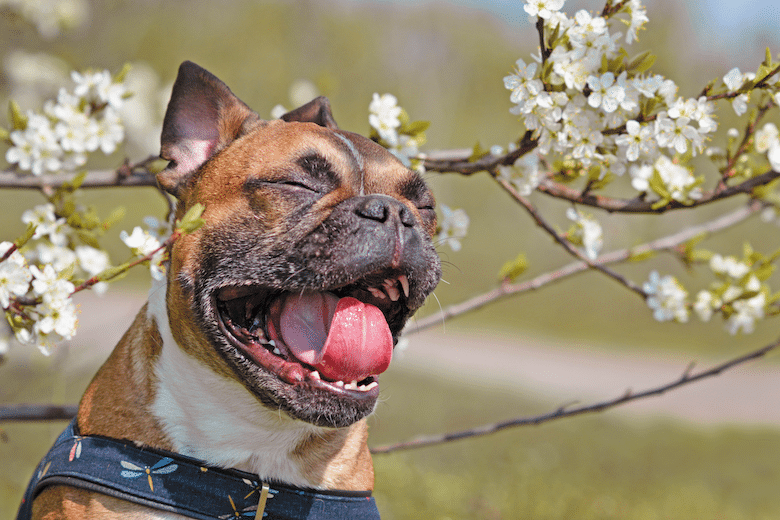I consider myself tech-savvy. I’m typically on the cutting edge of medical innovations, pushing technological boundaries and generally an early adopter of all things veterinary. I was one of the first veterinarians on Facebook, and I love leveraging virtual communication to better help my patients
Not long ago I was scrolling through my Instagram feed when a mention notification popped up. I clicked it, and a video of a dog coughing, open-mouthed breathing and generally struggling to suck in deep breaths appeared. The caption read, “@DrErnieWard, this is one of your patients. But is it asthma, tho?”
Worried (and a bit perplexed), I replied to contact the clinic immediately so we could examine the poor dog. Any pet experiencing difficulty breathing is considered a medical emergency. I didn’t know if this dog was suffering from a severe allergic reaction that could cut off his airway, worsening heart failure or heartworm disease, infection or chronic bronchitis. Asthma, or recurring episodes of airway inflammation, is exceedingly rare in dogs (though somewhat common in humans and cats). Many experts doubt that asthma exists as a canine clinical condition. Infection or an allergic reaction to environmental allergens or pollutants including smoke, mold, dust mites, cat dander or pollens was my primary concern as I hit “reply.”
A suspicious smell
An hour later I was listening intently to the breathing of an otherwise happy 4-year-old mixed breed Lab named Dorsey. As in Jack Dorsey, the co-founder of Twitter. Except the 20-something owners called him Dorso. That explained the “tho.” The “wheezing attack” had lessened a bit, but Dorso was still laboring to inhale. His owners reported he’d been like this for several days, and about a month ago Dorso “had a couple of bad days, then got better.” I didn’t have a diagnosis yet, though I had a pretty good idea what was going on. Let’s just say I’m particularly sensitive to smells and something had tripped an internal sniff alarm.
We ran a heartworm test, basic blood and urine tests, and chest X-rays. I wanted to determine if infection was involved, because infectious bronchitis (even ‘kennel cough’) can “wax and wane,” making diagnosis tricky. Heartworm disease can also create periodic allergic narrowing of the airways and eventually lead to respiratory and cardiac failure. Whenever I see a case such as this, it’s infectious until proven otherwise. This is critical because seemingly mild bronchitis can quickly result in life-threatening pneumonia.
The blood and urine tests were normal. The chest radiographs revealed a classic “lacy” lung pattern, suggestive of mucus and inflammation along the lining of the airways. It wasn’t extreme, indicating the condition was relatively recent. Bronchoscopy (a small camera inserted into the lung passages) or a tracheal wash (a procedure to evaluate samples from the upper airway) would be the next diagnostic steps. I didn’t think they were likely to be needed based on my presumptive whiff test.
As I reviewed my findings with the owner, my hunch was confirmed by a telltale square bulge in the owner’s shirt pocket. “How long have you smoked?”
The owner said his job had become stressful during the past few months, and he’d succumbed to his old cigarette habit. His partner scolded him and said the stench was unbearable. I agreed with an involuntary nose scrunch.
Fixing the problem
My therapeutic approach was straightforward: Eliminate the offending allergen and reduce the airway inflammation. I informed the owner that he’d need to either stop smoking or at least smoke outdoors, far away from Dorso. His partner snorted that he could take his smokes to another house.
Next, I administered a short-acting steroid injection in the office to provide quick relief and prescribed a short-term corticosteroid to open his bronchi and help remove the mucus. We would re-examine Dorso in two weeks to see if additional tests or treatment was needed. We discussed that if he had a “breathing attack” to immediately administer the steroid and get Dorso to a veterinarian. If he continued to suffer from chronic bronchitis, a rescue inhaler may be needed for emergency use.
Two weeks later Dorso came sashaying into my exam room. He greeted me with a sloppy kiss. I took the opportunity to steal a sniff from his coat. I was thrilled no odor alarms sounded, and he seemed completely happy and normal. The owner reported Dorso’s breathing had been perfect after the last visit. They had finished the meds, and, more importantly, had also ended the smoking relapse. Dorso would need to be monitored carefully for any further signs of bronchitis, as dogs that develop airway disease are at increased risk for future airway ailments.
Later that day, my phone buzzed, announcing I’d been “mentioned” on Instagram. The link took me to a picture of Dorso and I snuggling after our recheck. The owner described what had happened and thanked my staff for their help. I replied, “We love seeing Dorso. He’s the best patient! Glad it wasn’t asthma, tho.”






